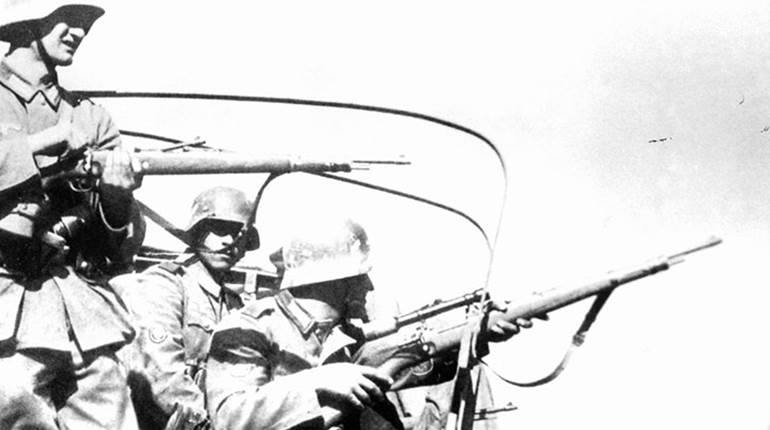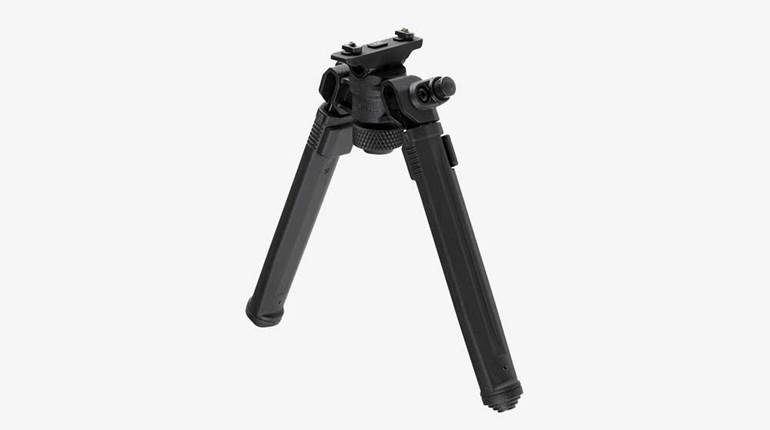
 Since the introduction of firearms, there has been one goal for both shooters and manufacturers—achieving the maximum possible accuracy. After all, what is the point of propelling a projectile of any sort at a target that it is unlikely to hit? For hunting this was a particularly vital requirement; but, for several generations, accuracy was a concept that did not bother most military commanders in the slightest.
Since the introduction of firearms, there has been one goal for both shooters and manufacturers—achieving the maximum possible accuracy. After all, what is the point of propelling a projectile of any sort at a target that it is unlikely to hit? For hunting this was a particularly vital requirement; but, for several generations, accuracy was a concept that did not bother most military commanders in the slightest. Muskets on the battlefield, like their forerunners, spears and arrows, were used en masse, forcing attackers to advance through a wall of projectiles, behind which the infantry would advance to close with the enemy, usually in brutal and very bloody close combat. A good medieval archer could send a war arrow up to 400 yds. and would have been perfectly capable of hitting a man-size target out to 300 yds. But such tactics were for the target butts and competitions, not for war. The success of the English archers at Agincourt and Crecy was based around the principle of hundreds of archers, shooting as fast as they could loose their arrows, putting thousands of projectiles into the sky and creating a blizzard of steel-tipped death.
The introduction of the firearm to the battlefield in the 14th century did not radically change this tactic as early handgonnes were large, crude, inaccurate and were used as much for creating fear and mayhem as for inflicting physical damage. Nonetheless, the firearm became ever more efficient and, by the 17th century, had become the predominant arm on the battlefield.
Even then, battles were of the linear type, whereby opposing sides faced each other at relatively close ranges, and musketeers loaded and fired as fast as possible—about four shots per minute—until they closed, when eventually one side broke and ran. By the English Civil War (1642-1651), pikes and swords were reserved purely for the last desperate melee as the opposing sides clashed. By the 18th century, the numbers of guns present on the battlefield had increased to the point where they had replaced almost all other infantry arms. This was primarily due to advances in manufacturing technology that had begun in the very early 18th century, using water, steam power and machinery to manufacture barrels and flintlocks. This was a precursor of what we regard today as mass production. Muskets were generally smoothbore, and the relatively crude arsenal-manufactured guns were capable of hitting a target at no more than 80 yds. Indeed, it was commonly said that, “No man was ever hit by a soldier aiming at him above two hundred paces distance.” For the purposes of linear warfare this was quite acceptable, and firing by volley produced devastating levels of casualties. The tactics worked, therefore accuracy was not regarded as a prerequisite for a soldier or his arm.
Technical innovation and reductions in manufacturing costs, however, meant that the introduction of the rifled barrel was to gradually alter the perception of how battles could be fought, albeit at a fairly glacial pace. The first widespread use of the rifle in warfare was during the American Revolutionary War (1775-1783). Although the bulk of American soldiers fought their battles in the accepted linear manner, armed with standard flintlock, smoothbore muskets, there were a relatively large number of militiamen who carried rifles. Many were backwoods or frontiersmen, who from the outset eschewed the uniform dress of the soldier and wore their own brand of sombre-hued, eminently practical clothing, comprising a mix of adopted Indian and European styles. This was the first indication of the less formal military nature of the work the riflemen began to undertake, acting as scouts, skirmishers and pickets. Whilst they did not wear camouflage, they were certainly harder to see than the brightly colored uniforms of the regular soldiers. More important though, were the rifles they carried, which had begun to evolve in America from the early heavy, club-butted military pattern to a more graceful, slender style, typically with a distinctive droop at the wrist. Many of these rifles were loosely based on the long-barreled, large-caliber British fowling pieces brought over by the settlers and the German Jäeger rifles that had been adopted by many of the German states from around 1730.
Neither pattern was ideally suited to the demands of frontier life, so the gunsmiths in the New World began to adapt them to designs that were more practical. The German military rifles were quite advanced for their time, being of smaller caliber than the common musket, and this trait was followed by the German immigrant gunsmiths who had settled along the East Coast of America. These new American rifles involved a mix of styles, sometimes copying the scrolled trigger guards of the Jäeger rifles to improve grip as well as adopting their brass or steel patch boxes but retaining the English form of full-length stocking and longer barrels. Barrel lengths began to shrink as well, from the 46" of a British Long Land Pattern musket, to around 40". Whereas a typical military musket was of .76 caliber, by the late 1770s, American-manufactured rifles were typically to be found in calibers between .45 and .60, although there were wide regional variations to be found.
The ranges at which these rifles were capable of shooting has been much disputed over the years, but a properly patched ball, fired by an experienced shot from a rifle or a smoothbore, was indeed a deadly arm. The comments made after the revolution by an Englishman who was both a veteran of the American war and a skilled shot, Maj. George Hanger, hold true. “I have many times asked the American backwoodsmen what … their best marksmen could do; they have constantly told me that an expert rifleman … can hit the head of a man at 200 yards. I am certain that provided an American rifleman was to get perfect aim at 300 yards at me standing still, he most undoubtedly would hit me, unless it was a very windy day.”
The British simply had no concept of the use of rifles, nor any idea about how to deal with the deadly aimed fire that the riflemen used against them. One description from a British officer, observing with a group of others during the Battle for New Orleans, is illuminating. “The figure of a tall man standing on the breastworks, dressed in linsey-woolsey, with buckskin leggings and a broad brimmed hat that fell around his face almost concealing his features. At last he moved, threw back his hat rim … and raised his rifle and took aim at our group. But the distance was so great we looked at each other and smiled. We saw the rifle flash. My right-hand companion … fell from his saddle. When again the rifle flashed, another of our party dropped to the earth.” Echoing the feelings of later generations of soldiers who faced sniper fire, the writer also commented: “The cannon and thousands of musket balls … we cared nothing for, for there was a chance of escaping them. But to know every time a rifle was levelled towards us … that the messenger of death drove unerringly to its goal, to know this and still march on was awful.” It is interesting to ponder on the fact that so novel was this experience that at no time did he or his companions feel it worthwhile moving out of range! Britain never really managed to respond effectively to the use of riflemen during the war, despite belatedly raising a company of its own under the command of Maj. Patrick Ferguson. The men were equipped with Ferguson’s own improved version of the French Chaumette-inspired screw-breech rifle. After Ferguson’s untimely and ironic death at the hands of American riflemen during the battle for King’s Mountain in October 1780, the British riflemen mysteriously faded from sight. It was to be two decades before rifles were again issued to British soldiers.
A few American commanders, such as Nathaniel Green and Daniel Morgan, understood both the use and limitations of putting riflemen on the battlefield, but they were in the minority. Using riflemen as ordinary infantry was near-suicidal, as they could only load slowly and had no method of attaching bayonets to their rifles. When overrun they were often butchered, against all the accepted rules of warfare. As one British officer tersely commented: “It frequently happens that they find themselves run through the body by the push of a bayonet, as a rifleman is not entitled to quarter.” This unpleasantly echoes the treatment often meted out to captured snipers up to the present day. Even Congress was not convinced about the practicality of the rifle. “If musketts were given them instead of rifles the service would be more benefitted, as there is a superabundance of riflemen in the army. Were it in the power of Congress to supply musketts they would speedily reduce the number of rifles and replace them … as they are more easily kept in order, can be fired oftener and have the advantage of bayonets.”
Although it cannot be claimed that these riflemen changed the course of American history, perhaps it is fair to say that they did, on occasion, nudge it in a different direction. Private Timothy Murphy famously killed Gen. Simon Fraser, which halted the British counterattack at Saratoga (Oct. 7, 1777), and Cdr. Perry’s use of shipboard riflemen during the Battle for Lake Erie in 1813—whose fire swept the British marines from the decks of their own vessels—contributed to Perry’s eventual victory. But the overall effect of riflemen on the battlefield was a minor one. Perhaps their greatest achievement was in demonstrating to the wider world that the days of the common musket were numbered, although it was to be a slowly learned lesson. Development of the rifle continued after the wars, mostly in the commercial marketplace, where demand for accurate longarms for hunting and self-defense continued to grow. This is not to say that the old smoothbores disappeared from use, for they were eminently adaptable, able to take charges of small shot for hunting small game, ball for larger quarry, or a mix of ball and buckshot, which was deadly for close-range defense.

But it was the invention in the early 1820s of a small copper cap containing a priming compound that was about to revolutionize shooting. The introduction of the percussion cap meant that for the first time, a firearm could be carried loaded and primed, ready for instantaneous use. No longer did a shooter have to consider the vagaries of the weather, where heavy rain or high winds could render a flintlock unusable. Neither was there the danger of moisture seeping in through an open touch-hole, reducing the main powder charge to useless mush. Nor was the shooter prone to flinch as he was blinded temporarily by the flash and smoke from the priming charge.
Whilst civilian shooters took to the new percussion guns with enthusiasm, the armies of the United States and Europe, ever cautious about wasting money, were far more reluctant to adopt the new technology. Although Britain had introduced small numbers of Baker rifles in 1803 (issued only to two Rifle regiments), it did not seriously consider the percussion system until 1838, and only then by converting existing smoothbores to percussion ignition. It was not until 1851 that the Minié rifle musket was adopted for general issue, a decision that was to have unforeseen repercussions in the United States within a few short years. Around Europe, most other armies were also re-equipping with percussion rifles. America, armed with a bewildering array of old muskets and patterns, looked hard at what was available and decided on the Model 1842 percussion musket, but, like the British government, only in smoothbore form as it, too, believed there was no justification for rifles.
If the U.S. military hadn’t quite caught up with rifle technology, the sports and hunting fraternity certainly had, as an engineer and shooter named N. Bosworth presciently wrote in his book A Treatise on Rifle, Musket, Pistol and Fowling Pieces in 1846. “The rifle in the hands of one who has studied its properties, will throw a ball with an accuracy that would surprise a large portion of those who are in the habit of using it. What we seriously want is more knowledge among the soldiery, both of guns and gunpowder.” In other words, Bosworth believed soldiers should be taught to shoot. Belatedly, as a stopgap measure, the U.S. Ordnance Dept. decided to adopt the U.S. Model 1841 rifle, which had seen considerable use in the Mexican War (1846-1848) and gained much praise. “The unerring aim of our Mississippi rifles, acting in concert, cast terror and dismay among the cowardly and unprincipled foe.” If the U.S. Ordnance Dept. was lacking in its desire to produce a viable, modern rifle musket for its army, there were other areas involving accurate shooting in which the United States was excelling.
It was not a moment too soon, either, for war was looming.









































